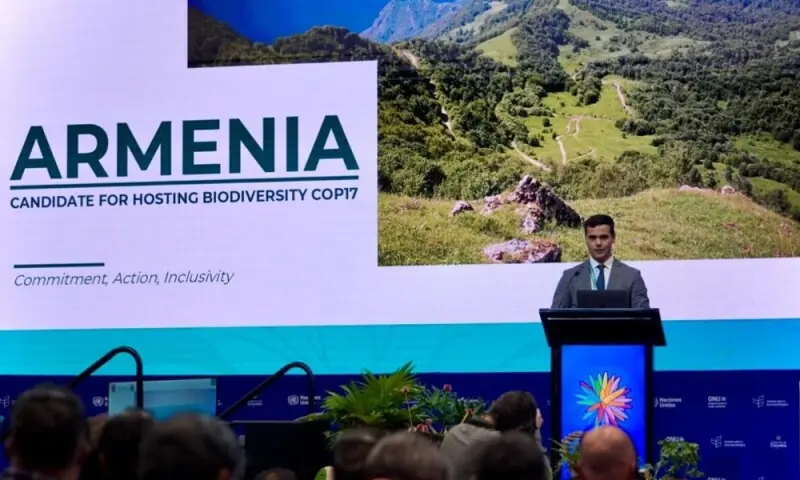By Alexandar Dounchev
Copyright brecorder

In October 2026, Armenia, a country with rich nature, rare species and unique landscapes, will host COP17, the largest international UN forum dedicated to the protection of biological diversity. Yet, behind these grand names and beautiful facades lies Armenia’s toxic legacy, which is rarely discussed openly: tailings ponds left behind by decades of mining. Located in one of the most seismically active regions of Eurasia, with poor monitoring and insufficient maintenance, they are a serious threat not only to ecosystems and biodiversity, but also to human health.
What are tailings ponds?
Unfortunately, the very term itself is familiar only to specialists and people directly affected by their toxic waste. These structures seem far from everyday life, but in reality, they are directly linked to the water, air and soil on which human health and survival depend. Tailings ponds are artificial reservoirs filled with waste from mining operations – a toxic mixture of heavy metals, cyanides and sulphides that can leak into rivers, groundwater and soil. And there are more than twenty such facilities in Armenia.
Lessons from disasters
Europe’s history already contains several cases when accidents at tailings ponds turned into tragedies of regional scale.
In 1998, a dam breach at the Los Frailes mine in Spain released millions of cubic metres of toxic sludge into the Guadiamar River valley. A wave of toxic mud covered farmland, destroyed fish and birds, leaving behind dozens of kilometres of dead land. The blow also hit Donana – the continent’s largest national park and a UNESCO World Heritage Site.
Just two years later, in 2000, a similar disaster occurred in Romania. At the Baia Mare gold mine, more than 100,000 cubic metres of cyanide-contaminated water spilled. When toxic sludge reached the Somes and Tisza rivers, it killed fish over a 400 km stretch, depriving of drinking water millions of people in Hungary and Serbia. At the time, this accident was called Europe’s biggest environmental disaster since Chernobyl.
One might consider these stories to be exceptions. However, international observers note that accidents at tailings ponds occur regularly, and their number is not decreasing. Earthworks cites the chain of disasters in recent decades as evidence of systemic failures and weaknesses, such as outdated designs, lack of control, and chronic underfunding. A recent report by Buildings notes that tailings ponds remain one of the most environmentally vulnerable links of global industry.
Armenian realities
Armenia fits into this troubling picture with particular sharpness. Many of its tailings ponds were inherited from the Soviet era, when environmental standards were minimal. The UNECE report explicitly states that all these facilities are located in a seismic zone, and earthquakes, landslides and seasonal floods greatly increase the risk of accidents. At the same time, their monitoring is irregular, equipment is outdated, and systematic inspections are often absent.
The World Bank notes that tailings ponds and abandoned ore dumps in Armenia are a ‘significant source of pollution,’ and weak institutional oversight only exacerbates environmental and social risks. Unlike the EU, where Directive 2006/21/EC established a system of independent monitoring, emergency funds and plans in case of a breach, Armenia has no public centralised register of tailings ponds. Data is scattered, and residents of the regions are often unaware of the threats hanging over their villages and towns.
For example, the Nahatak tailings pond, founded back in 1967 in the north of the country and covering an area equal to 24 football fields, has long been a cause for concern among environmentalists due of its location next to villages and rivers that feed local farms. In the event of an accident, the consequences would be immediate and irreversible.
In the Lori region, there is the Tegut tailings pond, which is connected to a large copper mine. Local residents complain about pollution of water and soil, and scientists have noted the threat to the biodiversity of the surrounding forests. Lori has always been considered a region with unique natural resources, but now its rivers are at risk of becoming carriers of toxins.
The most dangerous site in Armenia, according to environmentalists, is the Artsvanik tailings pond in the south of the country. It accumulates millions of tonnes of waste from the Zangezur Copper-Molybdenum Combine.
Experts from the Armenian Environmental Front claim that there is “virtually no biodiversity” below the dam: the water is saturated with heavy metals, and flora and fauna have been destroyed.
According to experts, the situation in the Ararat Valley is also very alarming, as it currently accumulates more than 15 million cubic metres of waste containing cyanides. This region is the heart of Armenia’s agriculture. Fruit and grapes are grown here, some of which are exported. Yet local soils show elevated levels of arsenic, cadmium, mercury and lead.
Human health and wildlife survival are under threat
For Armenia, as for the entire Caucasus, biodiversity is a strategic asset. Rare species live here, including the Armenian mouflon, the Caucasian leopard, and endemic species of trout. Preserving this wealth depends on clean water and sustainable ecosystems. A toxic accident in Armenia could have serious consequences for the entire region.
And the danger is not limited to nature. Tailings ponds accumulate arsenic, lead, and cyanides — substances that can easily enter groundwater and then the drinking water supplies. Their long-term impact on the body is already leading to an increase in cancer, neurological diseases, and deterioration in children’s health. The DAMAST study emphasises that in the absence of modern monitoring systems and emergency response plans in Armenia, the consequences of a possible accident would be sudden and devastating, leaving the population extremely vulnerable. And this is no exaggeration — in other countries, accidents at tailings ponds have forced entire villages to relocate.
On the eve of COP17: challenges and doubts
In a year’s time, when Yerevan hosts COP17, a landmark international forum on global ecology, delegates will be discussing forest protection, the conservation of rare species, and the restoration of ecosystems. But outside the conference halls of the Armenian capital, dozens of reservoirs containing toxic waste will remain, and an accident at one of them could negate all the talk about biodiversity. The lack of systematic waste management and the high risks to nature and human health raise an important question: is the world as a whole really prepared to match loud declarations on biodiversity conservation with real challenges on the ground?
The article does not necessarily reflect the opinion of Business Recorder or its owners.



